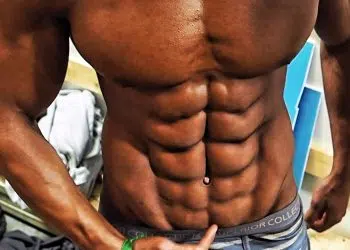The crunch! It’s a classic abdominal exercise that has set the standard by which all other core movements have been measured. But, is the standard crunch the best core exercise? Well, according to research conducted by Ace, it is for its “overall” effectiveness… and that’s based on Electromyographic (EMG) activity. (1)
However, it’s not the best for hitting every part of the abdominal wall, and the obliques. And that’s where the functional and effective reverse crunch shines.
The reverse crunch is a very effective exercise which targets the abdominal muscles of the core. You don’t need any equipment besides a soft surface so it’s a convenient movement which can be done anywhere for an effective workout. The reverse crunch is also very beneficial as it mimics a more natural movement and the exercise works the core stabilizer muscles.
You can attack your ab training from a whole new angle and stimulate different muscle fiber
So, let’s jump in to see how the reverse crunch can benefit you with more muscle gains and core strength…
What is a Reverse Crunch?

We’re glad you asked… the reverse crunch involves doing the movement from the opposite end (waist down) rather than by lifting the head and torso to contract the core muscles.
Level Up Your Fitness: Join our 💪 strong community in Fitness Volt Newsletter. Get daily inspiration, expert-backed workouts, nutrition tips, the latest in strength sports, and the support you need to reach your goals. Subscribe for free!
Now, you’re still stimulating the entire abdominal wall, but now, the lower abs and hip flexors are getting a lot of action!
How to Do The Reverse Crunch
Let’s make this simple and effective for you…
- Lie on your back and plant your feet on the floor with knees bent.
- Gently place your fingertips behind your head or place both arms down by your sides with palms on the floor.
- Bend knees at a 90-degree angle.
- Bring your knees toward your chest while contracting your core, then lift your butt off the ground and extend your legs straight toward the ceiling.
- Then, very slowly bring your butt back down and extend your legs back to the starting position.
- Repeat the reverse crunch for the desired number of reps.
Now, some people may not have the ability to perform the movement as instructed due to lack of mobility and flexibility. But, you can simply perform the reverse crunch without lifting your butt off the ground and extending your legs upward.
Exercise Tips:
There are a few things you should keep in mind to effectively work the core muscles. Safety is always a priority over any physical benefits. Here are some helpful tips to optimize the reverse crunch movement…
- Never pull on the back of your head if you choose this type of hand placement. You can hurt your neck this way and you won’t activate the core optimally.
- Do not use momentum or rock your body back and forth as this is dangerous for your back.
- Perform the exercise at a moderately slow pace to ensure the abdominals and obliques are contracting maximally.
- Make sure to perform controlled negatives as this allows the muscles to work during the entire repetition. This is necessary for muscle growth and core stabilization.
- When you extend your legs back down and straight out on the negative, you must remember to keep abs tight to protect your spine.
- ALWAYS keep your core tight to protect your lower back and spine (Very important)!
Variations
There are many ways to do one exercise. And sometimes variations are more convenient or effective.
So, let’s talk about popular reverse crunch variations…
Reverse crunch on a bench
If you’re not a fan of floor workouts then you can do the reverse crunch on a bench. It’s the same exact movement, however; you’ll grip the top of the bench near your head to stabilize your body.
Reverse crunch on a decline bench
You’ll have to be careful with this one but it can be done.
Lie upside down on the decline bench and grab the support handles which you’d normally secure your shins under. Then, perform the reverse crunch by keeping your core tight and performing the leg lift.
Hanging reverse crunch
Hang from some pull-up bars or use the arms supports to hold yourself up. Bend your knees and you’re your legs up past parallel as high as you can and extend your legs upward. Then, drop your legs slowly until they’re hanging down and extended.
This version will be a little more difficult since you don’t have back support as you would if lying on the floor. So, it’s best reserved for the more advanced.
Research shows a similar movement (Hanging leg raise) to be a little riskier since the rectus abdominis has to stabilize the pelvis during the exercise. This means more possible strain on the lumbar spine since the legs can place a heavy load on it. (4)
But, keeping your knees bent will significantly reduce the load on the spine during the hanging reverse crunch.
Which Muscles Are Involved?
The rectus abdominis (Abdominals) is the primary muscle group activated during the reverse crunch. The abdominals sit between the ribs and the pubic bone at the anterior of the pelvis. And these core muscles are responsible for trunk flexion, spine support, and stabilization of the upper body.
But… the internal and external obliques (Muscles along the outsides of your abdominals) also get a heck of a workout too.
Level Up Your Fitness: Join our 💪 strong community in Fitness Volt Newsletter. Get daily inspiration, expert-backed workouts, nutrition tips, the latest in strength sports, and the support you need to reach your goals. Subscribe for free!
And that’s why the reverse crunch is an excellent choice for any ab training routine.
Benefits
Like any effective exercise, there are plenty of benefits. (2)
Muscle and strength
The reverse crunch or any effective core movement contributes to the “6 pack” look, and it builds stabilizer muscles. Everyone wants sexy ab muscles to show off at the beach and now that it’s summer, there’s no better time to incorporate the reverse crunch in your ab routine.
Now, of course, your heavy compound lifts are important for core strength, but isolation work will only improve this.
And the hip flexors also reap benefits because of the flexion required during the movement. This is beneficial for mobility and strength in the lower body.
Stabilizer muscle development

Having strong stabilizer muscles is very important for doing any daily activity which requires physical movement. But, for people who train, they’re especially important for lifting maximum weight and decreasing the chance of experiencing pain during training.
Balance is also very important for functional activities and core training is a good way to improve. Elderly individuals can especially benefit from a good core training routine because it can improve their mobility and prevent falls.
So, stabilizer muscle development is a must for injury prevention. (3)
Sports and performance
Actions like hitting a tennis ball, jumping, bending and running all rely heavily on the core stabilizer muscles.
Better Posture
Since stabilizer muscles and a strong core play such a big role in spine support, having optimal strength in this area will improve your posture. and this is important for looking slimmer and even improving your breathing.
But when you lack core strength, the muscles weaken which can cause the spine to weaken over time.
How Many Sets/Reps Should I Do?
That’s another good question and we have a simple answer… it depends on your level of training experience and how many other ab exercises you’re doing.
But, here’s a general guideline…
If you’re a beginner, start small and do 2-3 sets of 15-20 reps. If you’re at an intermediate level, you can safely train using 3-4 sets with rep ranges of 8 or more.
And if you’re advanced, well… do what you can handle without overtraining because experience and knowing your body are a benefit of long-term training experience.
But, it’s always a good idea to train with mixed rep ranges to effectively progress in your training.
Final Thoughts
It is possible to reverse crunch your way to better abs (In combination with other effective exercises).
But, you must be consistent and use proper form to experience the gains you desire and to remain injury-free. So, take advantage of this useful information and follow the guidelines for effective reverse crunch training.
Developing your core is important for many reasons. And you can definitely improve your overall training progress by incorporating smart exercises which yield awesome results.
But remember, crunches will not burn fat directly as you’ll still need to be in a caloric deficit through diet and/or training to see your abs!
Interested in measuring your progress? Check out our strength standards for Hanging Leg Raise, Crunches.












I liked this article very much, I also published an article today related to this topic.